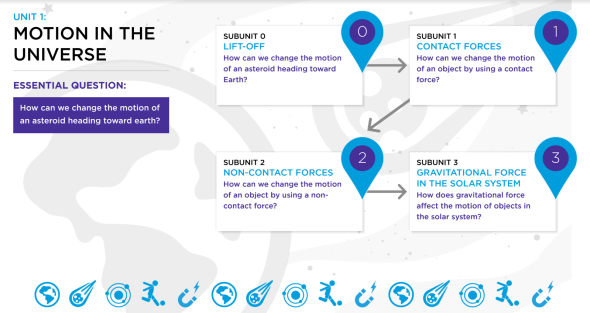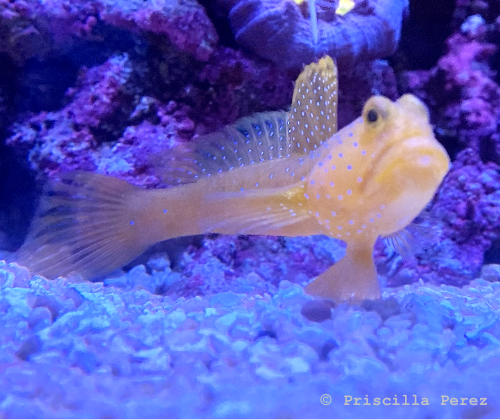
8th Grade Unit 1: Motion in the Universe Roadmap
After Unit 0: Groupwork, the 8th Grade science curriculum consists of 4 Units with 3 subunits.
This page hosts Unit 1: Motion in the Universe Roadmap with the 3 subunits within the unit.
Subunit 1: Contact Forces
Link to this section
Below you will view and download:
🟩 Subunit Assessment Opportunities
🟩 5E Lesson Sequence
Subunit 1: Assessment Opportunities
Subunit 1 Assessment Opportunities
View and download (by making a copy)- Subunit 1 Assessments
What should my students know and be able to do?
What should I prioritize?
Note: The materials below are personal recommendations from teachers in the field.
Feel free to consider your context when deciding whether to follow these suggestions.
|
|
|
|
|
|
|
|
|
|
|
|
|
|
|
|
|
|
|
|
|
|
|
|
|
|
|
|
|
|
|
|
|
|
|
|
|
|
|
|
|
|
|
|
|
|
|
|
|
|
View and download (by making a copy)- Subunit 1 Assessments
Subunit 1: 5E Lesson Sequence
Subunit Description
📂 Download ALL lessons at one time for Unit 1: Subunit 1 from this folder. 📂
In this subunit, students explore the concept that the motion of an object is determined by the sum of the forces acting on it. Students learn that if the net force on the object is not zero, its motion will change. Students also learn that the greater the mass of the object, the greater the force needed to achieve the same change in motion. For any given object, a larger force causes a larger change in motion. For any pair of interacting objects, the force exerted by the first object on the second object is equal in strength to the force that the second object exerts on the first, but in the opposite direction. Students apply what they learn to come up with a solution to change the motion of an asteroid using a contact force.
| Lesson | Lesson Name | Teacher Document | Student Handout |
|---|---|---|---|
| 1 | Engage |
|
|
| 2 | Explore 1 | ||
| 3 | Explain 1 | ||
| 4 | Explore 2 | 8.1 SU1 4Explore 2 Teacher | |
| 5 | Explain 2 | 8.1 SU1 5Explain 2 Teacher | 8.1 SU1 5Explain 2 Student |
| 6 | Explore 3 | 8.1 SU1 6Explore 3 Teacher | |
| 7 | Explore 3 | 8.1 SU1 7Explain 3 Teacher | 8.1 SU1 7Explain 3 Student |
| 8 | Elaborate | 8.1 SU1 8Elaborate Teacher | 8.1 SU1 8Elaborate Student |
| 9 | Evaluate | 8.1 SU1 9Evaluate Student | |
📂 Download ALL lessons at one time for Unit 1: Subunit 1 from this folder. 📂
Subunit 2: Non-Contact Forces
Link to this section
Below you will view and download:
🟩 Subunit Assessment Opportunities
🟩 5E Lesson Sequence
Subunit 2: Assessment Opportunities
Subunit 2 Assessment Opportunities
What should my students know and be able to do?
What should I prioritize?
Note: The materials below are personal recommendations from teachers in the field.
Feel free to consider your context when deciding whether to follow these suggestions.
|
|
|
|
|
|
|
|
|
|
|
|
|
|
|
|
|
|
|
|
|
|
|
|
|
|
|
|
|
|
View and download (by making a copy)- Subunit 2 Assessments
Subunit 2: 5E Lesson Sequence
Subunit Description
📂 Download ALL lessons at one time for Unit 1: Subunit 2 from this folder. 📂
In this subunit, students explore non-contact forces, including electrostatic, magnetic, and gravitational force. Students learn that these forces act at a distance and can be explained by fields that extend through space. Students investigate how electrostatic and magnetic forces can be attractive or repulsive and that their sizes depend on the magnitudes of the charges or magnetic strengths involved as well as the distances between the interacting objects. Students investigate how gravitational forces are always attractive. There is a gravitational force between any two masses, but it is very small except when one or both of the objects have large mass.
| Lesson | Lesson Name | Teacher Document | Student Handout |
|---|---|---|---|
| 1 | Engage | ||
| 2 | Explore | ||
| 3 | Explain | ||
| 4 | Elaborate | 8.1 SU2 4Elaborate Teacher | 8.1 SU2 4Elaborate Student |
| 5 | Evaluate | 8.1 SU2 5Evaluate Student | |
📂 Download ALL lessons at one time for Unit 1: Subunit 2 from this folder. 📂
Subunit 3: Gravitational Force in the Solar System
Link to this section
Below you will view and download:
🟩 Subunit Assessment Opportunities
🟩 5E Lesson Sequence
Subunit 3: Assessment Opportunities
Subunit 3 Assessment Opportunities
What should my students know and be able to do?
What should I prioritize?
Note: The materials below are personal recommendations from teachers in the field.
Feel free to consider your context when deciding whether to follow these suggestions.
|
|
|
|
|
|
|
|
|
|
|
|
|
Students can observe Earth orbiting the sun, Earth with the moon in orbit, Earth and the moon orbiting the sun, the moon orbiting Earth, and a man-made satellite moving in orbit around Earth. |
|
|
|
|
|
|
|
|
|
|
|
|
|
|
|
|
View and download (by making a copy)- Subunit 3 Assessments
Subunit 3: 5E Lesson Sequence
Subunit Description
📂 Download ALL lessons at one time for Unit 1: Subunit 3 from this folder. 📂
In this subunit, students continue to explore gravitational force. They investigate how the solar system consists of the sun and a collection of objects, including planets, their moons, and asteroids. These bodies are all held in orbit around the sun by its gravitational pull on them.
| Lesson | Lesson Name | Teacher Document | Student Handout |
|---|---|---|---|
| 1 | Engage |
|
|
| 2 | Explore | ||
| 3 | Explain | ||
| 4 | Elaborate | 8.1 SU3 4Elaborate Teacher | 8.1 SU3 4Elaborate Student |
| 5 | Evaluate | 8.1 SU3 5Evaluate Student | |
📂 Download ALL lessons at one time for Unit 1: Subunit 3 from this folder. 📂
Unit 1: Motion in the Universe Documents
Link to this section
Below you will view and download: Unit Plan, Standards, Culminating Project Assessments and Rubrics, Common Misconceptions, Materials, Unit 0: Lift-Off Lessons and Resources.
8.1 Motion in the Universe: Overview
Overview
Through investigations, students consider the relationship between forces and motion. In Subunit 1, students gather evidence to support the concept that changes to an object’s motion depend on the sum of the forces acting on the object and the mass of the object. Students use contact forces to design a solution to a problem involving the motion of two objects on a path for collision: Earth and an asteroid. In Subunit 2, students ask questions and construct experiments to determine the factors that affect the strength of electrostatic, magnetic, and gravitational forces. Students return to the problem of an asteroid heading toward Earth, this time considering how a non-contact force might solve the problem. In Subunit 3, students develop a model to describe the role of gravity in the motions of objects within the solar system, including that of the asteroid and Earth.
For the Group Culminating Project, students work together to prepare a news article that describes a solution to prevent an asteroid from colliding with Earth. Students use their understanding of forces and motion to come up with the solution. For the Individual Culminating Project, each student provides a description of an alternative solution to avoid the collision.
8.1 Motion in the Universe: Unit Plan
Unit 1: Motion in the Universe - Unit Plan
|
|
||
|
|
||
|
Apply Newton’s Third Law to design a solution to a problem involving the motion of two colliding objects. [Clarification Statement: Examples of practical problems could include the impact of collisions between two cars, between a car and stationary objects, and between a meteor and a space vehicle.] [Assessment Boundary: Assessment is limited to vertical or horizontal interactions in one dimension.] [Clarification Statement: Emphasis is on balanced (Newton’s First Law) and unbalanced forces in a system, qualitative comparisons of forces, mass and changes in motion (Newton’s Second Law), frame of reference, and specification of units.] [Assessment Boundary: Assessment is limited to forces and changes in motion in one-dimension in an inertial reference frame and to change in one variable at a time. Assessment does not include the use of trigonometry.] [Clarification Statement: Examples of devices that use electric and magnetic forces could include electromagnets, electric motors, or generators. Examples of data could include the effect of the number of turns of wire on the strength of an electromagnet, or the effect of increasing the number or strength of magnets on the speed of an electric motor.] [Assessment Boundary: Assessment about questions that require quantitative answers is limited to proportional reasoning and algebraic thinking.] [Clarification Statement: Examples of evidence for arguments could include data generated from simulations or digital tools; and charts displaying mass, strength of interaction, distance from the Sun, and orbital periods of objects within the solar system.] [Assessment Boundary: Assessment does not include Newton’s Law of Gravitation or Kepler’s Laws.] Conduct an investigation and evaluate the experimental design to provide evidence that fields exist between objects exerting forces on each other even though the objects are not in contact. [Clarification Statement: Examples of this phenomenon could include the interactions of magnets, electrically-charged strips of tape, and electrically-charged pith balls. Examples of investigations could include first-hand experiences or simulations.] [Assessment Boundary: Assessment is limited to electric and magnetic fields, and limited to qualitative evidence for the existence of fields.]
|
|
|
|
|
||
|
|
||
|
|
||
|
|
||
|
|
||
|
|
||
|
|
||
|
|
||
|
|
||
|
|
|
|
|
|
||||
|
|
|
|
|
|
|
|
|
|
|
|
|
|
|
|
|
|
|
|
|
|
||
|
|
|
|||
|
|
||||
|
|
|
|
||
|
|
|
|||
|
|
||||
|
|
|
|
|
|
|
|
|
|
|
|
|
|
|
|
|
|
|
|
|
|||
|
|
|
|||
|
|
|
|
||
|
|
|
|
||
|
|
|
|
||
|
|
|
|
||
“Disciplinary Core Ideas, Science and Engineering Practices, and Crosscutting Concepts” are reproduced verbatim from A Framework for K-12 Science Education: Practices, Crosscutting Concepts, and Core Ideas. DOI: https://doi.org/10.17226/13165. National Research Council; Division of Behavioral and Social Sciences and Education; Board on Science Education; Committee on a Conceptual Framework for New K-12 Science Education Standards. National Academies Press, Washington, DC. This material may be reproduced for noncommercial purposes and used by other parties with this attribution. If the original material is altered in any way, the attribution must state that the material is adapted from the original. All other rights reserved.
8.1 Motion in the Universe: Standards
Motion in the Universe
Next Generation Science Standards Performance Expectations
|
|
Assessment Boundary: Assessment is limited to vertical or horizontal interactions in one dimension.] |
|
|
Assessment Boundary: Assessment is limited to forces and changes in motion in one-dimension in an inertial reference frame and to change in one variable at a time. Assessment does not include the use of trigonometry.] |
|
|
[Clarification Statement: Examples of devices that use electric and magnetic forces could include electromagnets, electric motors, or generators. Examples of data could include the effect of the number of turns of wire on the strength of an electromagnet, or the effect of increasing the number or strength of magnets on the speed of an electric motor.] [Assessment Boundary: Assessment about questions that require quantitative answers is limited to proportional reasoning and algebraic thinking.] |
|
|
Assessment Boundary: Assessment does not include Newton’s Law of Gravitation or Kepler’s Laws.] |
|
|
even though the objects are not in contact. [Clarification Statement: Examples of this phenomenon could include the interactions of magnets, electrically-charged strips of tape, and electrically-charged pith balls. Examples of investigations could include first-hand experiences or simulations.] [Assessment Boundary: Assessment is limited to electric and magnetic fields, and limited to qualitative evidence for the existence of fields.] |
|
|
|
NGSS Lead States. 2013. Next Generation Science Standards: For States, By States. Washington, DC: The National Academies Press.
Disciplinary Core Ideas
PS2.A: Forces and Motion
- For any pair of interacting objects, the force exerted by the first object on the second object is equal in strength to the force that the second object exerts on the first, but in the opposite direction (Newton’s third law).
- The motion of an object is determined by the sum of the forces acting on it; if the total force on the object is not zero, its motion will change. The greater the mass of the object, the greater the force needed to achieve the same change in motion. For any given object, a larger force causes a larger change in motion.
- All positions of objects and the directions of forces and motions must be described in an arbitrarily chosen reference frame and arbitrarily chosen units of size. In order to share information with other people, these choices must also be shared.
PS2.B: Types of Interactions
- Electric and magnetic (electromagnetic) forces can be attractive or repulsive, and their sizes depend on the magnitudes of the charges, currents, or magnetic strengths involved and on the distances between the interacting objects.
- Gravitational forces are always attractive. There is a gravitational force between any two masses, but it is very small except when one or both of the objects have large mass—e.g., Earth and the sun.
- Forces that act at a distance (electric, magnetic, and gravitational) can be explained by fields that extend through space and can be mapped by their effect on a test object (a charged object, or a ball, respectively).
ESS1.B: Earth and the Solar System
- The solar system consists of the sun and a collection of objects, including planets, their moons, and asteroids that are held in orbit around the sun by its gravitational pull on them.
Science and Engineering Practices
Constructing Explanations and Designing Solutions
Constructing explanations and designing solutions in 6–8 builds on K–5 experiences and progresses to include constructing explanations and designing solutions supported by multiple sources of evidence consistent with scientific ideas, principles, and theories.
- Apply scientific ideas or principles to design an object, tool, process or system. (MS-PS2-1)
Planning and Carrying Out Investigations
Planning and carrying out investigations to answer questions or test solutions to problems in 6–8 builds on K–5 experiences and progresses to include investigations that use multiple variables and provide evidence to support explanations or design solutions.
- Plan an investigation individually and collaboratively, and in the design: identify independent and dependent variables and controls, what tools are needed to do the gathering, how measurements will be recorded, and how many data are needed to support a claim. (MS-PS2-2)
- Conduct an investigation and evaluate the experimental design to produce data to serve as the basis for evidence that can meet the goals of the investigation. (MS-PS2-5)
*Asking Questions and Defining Problems (Focal Practice)
Asking questions and defining problems in grades 6–8 builds from grades K–5 experiences and progresses to specifying relationships between variables, and clarifying arguments and models.
- Ask questions that can be investigated within the scope of the classroom, outdoor environment, and museums and other public facilities with available resources and, when appropriate, frame a hypothesis based on observations and scientific principles. (MS-PS2-3)
Engaging in Argument from Evidence
Engaging in argument from evidence in 6–8 builds from K–5 experiences and progresses to constructing a convincing argument that supports or refutes claims for either explanations or solutions about the natural and designed world.
- Construct and present oral and written arguments supported by empirical evidence and scientific reasoning to support or refute an explanation or a model for a phenomenon or a solution to a problem. (MS-PS2-4)
Developing and Using Models
Modeling in 6–8 builds on K–5 experiences and progresses to developing, using, and revising models to describe, test, and predict more abstract phenomena and design systems.
- Develop and use a model to describe phenomena. (MS-ESS1-2)
Crosscutting Concepts
Patterns
- Observed patterns of forms and events guide organization and classification, and they prompt questions about relationships and the factors that influence them.
Scale, Proportion, and Quantity
- Time, space, and energy phenomena can be observed at various scales using models to study systems that are too large or too small.
Stability and Change
- Explanations of stability and change in natural or designed systems can be constructed by examining the changes over time and forces at different scales. (MS-PS2-2)
Cause and Effect
- Cause and effect relationships may be used to predict phenomena in natural systems. (MS-PS2-3)(MS-PS2-5)
*Systems and System Models (Focal Crosscutting Concept)
- Models can be used to represent systems and their interactions—such as inputs, processes and outputs—and energy and matter flows within systems. (MS-PS2-1)(MS-PS2-4)(MS-ESS1-2)
“Disciplinary Core Ideas, Science and Engineering Practices, and Crosscutting Concepts” are reproduced verbatim from A Framework for K-12 Science Education: Practices, Crosscutting Concepts, and Core Ideas. DOI: https://doi.org/10.17226/13165. National Research Council; Division of Behavioral and Social Sciences and Education; Board on Science Education; Committee on a Conceptual Framework for New K-12 Science Education Standards. National Academies Press, Washington, DC. This material may be reproduced for noncommercial purposes and used by other parties with this attribution. If the original material is altered in any way, the attribution must state that the material is adapted from the original. All other rights reserved.
Connections to the Nature of Science
Scientific Knowledge Assumes an Order and Consistency in Natural Systems
-
Science assumes that objects and events in natural systems occur in consistent patterns that are understandable through measurement and observation. (MS-ESS1-2)
Scientific Knowledge is Based on Empirical Evidence
- Science knowledge is based upon logical and conceptual connections between evidence and explanations. (MS-PS2-2)(MS-PS2-4)
Connections to Engineering, Technology, and Applications of Science
Influence of Science, Engineering, and Technology on Society and the Natural World
- The uses of technologies and any limitations on their use are driven by individual or societal needs, desires, and values; by the findings of scientific research; and by differences in such factors as climate, natural resources, and economic conditions. (MS-PS2-1)
NGSS Lead States. 2013. Next Generation Science Standards: For States, By States. Washington, DC: The National Academies Press.
Link to Connect the 8th Grade Motion in the Universe Unit with Prior Knowledge
8.1 Motion in the Universe: Culminating Project Assessments and Rubrics
Culminating Project Assessments and Rubrics
📂Download ALL files from 8.1 Culminating Project Assessments folder.📂
| Culminating Project File Docs |
|---|
| 8.1 Main–Culminating Projects |
| 8.1 Oral Presentation Rubric |
| 8.1 Science and Engineering Content Rubric |
| 8.1 Science and Engineering Practices Rubric |
📂Download ALL files from 8.1 Culminating Project Assessments folder.📂
8.1 Motion in the Universe: Common Misconceptions
Common Misconceptions
Lift-Off
How can we change the motion of an asteroid heading toward Earth?
|
|
|
|
|
|
Subunit 1: Contact Forces
How can we change the motion of an object by using a contact force?
|
|
|
|
|
|
|
|
|
|
|
|
|
|
|
Subunit 2: Non-Contact Forces
How can we change the motion of an object by using a non-contact force?
|
|
|
|
|
|
Subunit 3: Gravitational Force in the Solar System
How does gravitational force affect the motion of objects in the solar system?
|
|
|
|
|
|
|
|
|
|
|
|
NGSS Lead States. 2013. Next Generation Science Standards: For States, By States. Washington, DC: The National Academies Press.
“Disciplinary Core Ideas” are reproduced verbatim from A Framework for K-12 Science Education: Practices, Crosscutting Concepts, and Core Ideas. DOI: https://doi.org/10.17226/13165. National Research Council; Division of Behavioral and Social Sciences and Education; Board on Science Education; Committee on a Conceptual Framework for New K-12 Science Education Standards. National Academies Press, Washington, DC. This material may be reproduced for noncommercial purposes and used by other parties with this attribution. If the original material is altered in any way, the attribution must state that the material is adapted from the original. All other rights reserved.
8.1 Motion in the Universe: Materials
Materials
View and download (by making a copy) of Materials
The Unit 1: Motion in the Universe Materials table includes all of the items needed to teach five sections of this unit in a classroom of 32 students (eight groups of four.) A detailed breakdown of how these items are used throughout the unit can be found in your Teacher Background Section at the subunit level and in each individual lesson in your Teacher Edition.
- Permanent materials have already been provided to all middle schools in the district and are expected to be reused from year to year.
- Consumable materials are replenished on an as-needed basis from year to year.
- Teacher Provided materials must be supplied by teachers each year.
Unit 1: Motion in the Universe Materials
|
|
|
|
|
|
|
|
View and download (by making a copy) of Materials
8.1 Motion in the Universe: Subunit 0: Lift-Off Lessons
Subunit 0: Lift-Off
📂 Download ALL lessons at one time for Subunit 0: Lift-Off from this folder.📂
Lessons
| Lift-Off Lesson Documents |
|---|
| 8.1 SU0 General Groupwork Slide |
| 8.1 SU0 Liftoff Slides |
| 8.1 SU0 Liftoff Teacher |
| 8.1 SU0 Liftoff Student |
📂 Download ALL lessons at one time for Subunit 0: Lift-Off from this folder.📂
8.1 Motion in the Universe: Want to know more about this unit?
Want to know more about this unit?
View and download (by making a copy) of Resources
Resources
Here are some resources for Unit 8.1 Motion in the Universe:
Lift-Off and Culminating Project
Solar System
NASA: Planets
“Overview.” NASA. NASA. Accessed November 18, 2019. https://solarsystem.nasa.gov/planets/overview/.
NASA Space Place in a Snap: The Solar System's Formation
“Space Place in a Snap: The Solar System's Formation Video.” NASA. NASA, July 1, 2015. https://www.jpl.nasa.gov/edu/learn/video/space-place-in-a-snap-the-solar-systems-formation.
Planetary Defense
NASA: Planetary Defense Coordination Office
Talbert, Tricia. “Planetary Defense Coordination Office.” NASA. NASA, December 22, 2015. https://www.nasa.gov/planetarydefense/overview.
Talbert, Tricia. “Planetary Defense Frequently Asked Questions.” NASA. NASA, December 29, 2015. https://www.nasa.gov/planetarydefense/faq.
The Planetary Society: Five Steps to Prevent Asteroid Impacts
“Five Steps to Prevent Asteroid Impacts.” The Planetary Society Blog. Accessed March 27, 2020. https://www.planetary.org/blogs/bruce-betts/2015/0630-5-steps-to-preventing-asteroid-impact.html.
KQED QUEST: Asteroid Hunter
YouTube. KQED QUEST: Astriod Hunter. Accessed November 18, 2019. https://www.youtube.com/watch?v=z9iGFbyZELw.
NASA: JPL Small-Body Database Browser
“JPL Small-Body Database Browser.” NASA. NASA. Accessed November 18, 2019. https://ssd.jpl.nasa.gov/sbdb.cgi.
Subunit 1: Contact Forces
Types of Forces
The Physics Classroom: Types of Forces
“The Physics Classroom Tutorial.” The Physics Classroom. Accessed November 18, 2019. https://www.physicsclassroom.com/class/newtlaws/Lesson-2/Types-of-Forces.
Note that the author of The Physics Classroom allows use through a live Internet connection only. For full terms of use, review About the Physics Classroom (http://www.physicsclassroom.com/about).
Balanced and Unbalanced Forces
The Physics Classroom: Balanced and Unbalanced Forces
“The Physics Classroom Tutorial.” The Physics Classroom. Accessed November 18, 2019. https://www.physicsclassroom.com/class/newtlaws/Lesson-1/Inertia-and-Mass.
Newton’s First Law of Motion
The Physics Classroom: Inertia and Mass
“The Physics Classroom Tutorial.” The Physics Classroom. Accessed November 18, 2019. https://www.physicsclassroom.com/class/newtlaws/Lesson-1/Inertia-and-Mass.
Newton’s Second Law of Motion
The Physics Classroom: Newton's Second Law
“The Physics Classroom Tutorial.” The Physics Classroom. Accessed November 18, 2019. https://www.physicsclassroom.com/class/newtlaws/Lesson-3/Newton-s-Second-Law.
Acceleration
The Physics Classroom: Acceleration
“Acceleration.” The Physics Classroom. Accessed November 18, 2019. https://www.physicsclassroom.com/Class/1DKin/U1L1e.cfm.
The Physics Classroom: Positive Velocity and Negative Acceleration
“Rightward Velocity with a Leftward Acceleration.” The Physics Classroom. Accessed November 18, 2019. https://www.physicsclassroom.com/mmedia/kinema/pvna.cfm.
Newton’s Third Law of Motion
Bozeman Science: Newton's Third Law
YouTube. YouTube. Accessed November 18, 2019. https://www.youtube.com/watch?v=91QYouih4bQ.
The Physics Classroom: Newton's Third Law
“The Physics Classroom Tutorial.” The Physics Classroom. Accessed November 18, 2019. https://www.physicsclassroom.com/class/newtlaws/Lesson-4/Newton-s-Third-Law.
Newton’s Third Law Video 1 - Medicine Ball Catch and Throw
YouTube. YouTube. Accessed November 18, 2019. https://www.youtube.com/watch?v=91QYouih4bQ.
Newton's Third Law Video 2 - Newton’s Third Law Explained with Skateboard, Rocket
YouTube. YouTube. Accessed November 18, 2019. https://www.youtube.com/watch?v=Xx9kiF00rts.
Subunit 2: Non-Contact Forces
Demonstrations and Activities
“Science Snacks: Projects and Activities You Can Do!” Exploratorium, October 30, 2019. https://www.exploratorium.edu/snacks.
Electrostatic Force
The Physics Classroom: Static Electricity
“The Physics Classroom Tutorial.” The Physics Classroom. Accessed November 18, 2019. https://www.physicsclassroom.com/class/estatics.
Magnetic Force
College Physics for AP Courses
]AP® Courses.” OpenStax. Accessed November 18, 2019. https://openstax.org/books/college-physics-ap-courses/pages/22-1-magnets.
Gravitational Force
The Physics Classroom: Gravity Is More Than a Name
“Magnets - College Physics for “The Physics Classroom Tutorial.” The Physics Classroom. Accessed November 18, 2019. https://www.physicsclassroom.com/class/circles/Lesson-3/Gravity-is-More-Than-a-Name.
Subunit 3: Gravitational Force in the Solar System
The Physics Classroom: Circular Motion Principle for Satellites
“The Physics Classroom Tutorial.” The Physics Classroom. Accessed November 18, 2019. https://www.physicsclassroom.com/class/circles/Lesson-4/Circular-Motion-Principles-for-Satellites.
NASA Space Place: Newton's Cannon
“Shoot a Cannonball into Orbit!” NASA. NASA, February 13, 2013. https://spaceplace.nasa.gov/how-orbits-work/en/.
NASA Space Place: What Is Gravity
“What Is Gravity?” NASA. NASA, October 14, 2019. https://spaceplace.nasa.gov/what-is-gravity/en/.
NASA: What Is an Orbit?
Dunbar, Brian. “What Is Orbit?” NASA. NASA, June 1, 2015. https://www.nasa.gov/audience/forstudents/5-8/features/nasa-knows/what-is-orbit-58.html.
Assessment Resources
Stanford University: Stanford NGSS Assessment Project, Short-Response Items
“Short-Response Items.” Short-response items | Stanford NGSS Assessment Project. Accessed November 18, 2019. https://snapgse.stanford.edu/snap-assessments/short-response-items.
Other Resources Used in 8.1 Motion in the Universe
“About.” The Physics Classroom. Accessed November 18, 2019.
https://www.physicsclassroom.com/about.
“Acceleration.” The Physics Classroom. Accessed November 18, 2019. https://www.physicsclassroom.com/Class/1DKin/U1L1e.cfm.
Asteroid Hunters YouTube. YouTube. Accessed November 18, 2019. https://www.youtube.com/watch?v=z9iGFbyZELw.
Bonilla, Dennis. “Gravity Tractor.” NASA. NASA, March 16, 2015. https://www.nasa.gov/content/asteroid-grand-challenge/mitigate/gravity-tractor.
“Center for NEO Studies.” NASA. NASA. Accessed November 18, 2019.
https://cneos.jpl.nasa.gov/.
Dunbar, Brian. “What Is Orbit?” NASA. NASA, June 1, 2015. https://www.nasa.gov/audience/forstudents/5-8/features/nasa-knows/what-is-orbit-58.html.
Dunbar, Brian. “NASA Rules Out Earth Impact in 2036 for Asteroid Apophis.” NASA. NASA, April 24, 2019. https://www.nasa.gov/mission_pages/asteroids/news/asteroid20130110.html.
Fox, Steve. “Asteroid and Comet Watch Videos.” NASA. NASA, January 23, 2015. https://www.nasa.gov/mission_pages/asteroids/videos/index.html.
Gravity Experiment YouTube. YouTube. Accessed November 18, 2019. https://www.youtube.com/watch?v=E43-CfukEgs
NASA Asteroids and Comets YouTube. YouTube. Accessed November 18, 2019. https://www.youtube.com/watch?v=uGKY-XzFeNU.
NASA JPL Small-Body Database Browser NASA. NASA. Accessed November 18, 2019. https://ssd.jpl.nasa.gov/sbdb.cgi.
Newton's Laws on Board the International Space Station video YouTube. YouTube. Accessed November 18, 2019. https://www.youtube.com/watch?v=KvPF0cQUW7s.
Newton's Third Law video YouTube. YouTube. Accessed November 18, 2019. https://www.youtube.com/watch?v=91QYouih4bQ.
PhET Forces and Motion: Basics simulation. PhET Interactive Simulations, University of Colorado Boulder, https://phet.colorado.edu.
“Radar Observations Refine the Future Motion of Asteroid 2004 MN4.” NASA. NASA. Accessed November 18, 2019. https://cneos.jpl.nasa.gov/news/news149.html.
“Rightward Velocity with a Leftward Acceleration.” The Physics Classroom. Accessed November 18, 2019. https://www.physicsclassroom.com/mmedia/kinema/pvna.cfm.
“Shoot a Cannonball into Orbit!” NASA. NASA, February 13, 2013. https://spaceplace.nasa.gov/how-orbits-work/en/.
“Space Place in a Snap: The Solar System's Formation Video.” NASA. NASA, July 1, 2015. https://www.jpl.nasa.gov/edu/learn/video/space-place-in-a-snap-the-solar-systems-formation.
“The Physics Classroom Tutorial.” The Physics Classroom. Accessed November 18, 2019. https://www.physicsclassroom.com/class/newtlaws/Lesson-2/Types-of-Forces.
“The Physics Classroom Tutorial.” The Physics Classroom. Accessed November 18, 2019. https://www.physicsclassroom.com/class/newtlaws/Lesson-1/Balanced-and-Unbalanced-Forces.
“The Physics Classroom Tutorial.” The Physics Classroom. Accessed November 18, 2019. https://www.physicsclassroom.com/class/newtlaws/Lesson-1/Inertia-and-Mass.
“The Physics Classroom Tutorial.” The Physics Classroom. Accessed November 18, 2019. https://www.physicsclassroom.com/class/newtlaws/Lesson-3/Newton-s-Second-Law.
“The Physics Classroom Tutorial.” The Physics Classroom. Accessed November 18, 2019. https://www.physicsclassroom.com/class/newtlaws/Lesson-4/Newton-s-Third-Law.
“The Physics Classroom Tutorial.” The Physics Classroom. Accessed November 18, 2019. https://www.physicsclassroom.com/class/circles/Lesson-3/Gravity-is-More-Than-a-Name.
“The Physics Classroom Tutorial.” The Physics Classroom. Accessed November 18, 2019. https://www.physicsclassroom.com/class/circles/Lesson-4/Circular-Motion-Principles-for-Satellites.
“The Physics Classroom Tutorial.” The Physics Classroom. Accessed November 18, 2019. https://www.physicsclassroom.com/Physics-Interactives/Static-Electricity/Coulomb-s-Law
“The Physics Classroom Tutorial.” The Physics Classroom. Accessed November 18, 2019. http://www.physicsclassroom.com/class/newtlaws/Lesson-1/State-of-Motion.
“YOUR WEIGHT ON OTHER WORLDS.” Exploratorium. Accessed November 18, 2019. https://www.exploratorium.edu/ronh/weight/.
“Whack-a-Stack.” Exploratorium, April 18, 2017 https://www.exploratorium.edu/snacks/whack-a-stack.
View and download (by making a copy) of Resources
Note: The CC BY-NC 4.0 License does not apply to photos, images, articles, and other materials within the curriculum that have been licensed by San Francisco Unified School District and Stanford University (the Authors). These include but are not limited to photos from commercial stock photo/image agencies such as Shutterstock.com or Getty Images (iStock.com) and photos or graphics where the Authors obtained permission from organizations such as UCMP or SERP. This CC BY-NC 4.0 License also does not apply to articles that the Authors received permission to reprint [Reprinted with Permission]. You can identify such a photo, image, or licensed material by looking at the credit embedded within or associated with the content. You are allowed to reproduce the licensed material for your own personal, classroom, non-commercial use only, BUT (i) you may not modify, alter, adapt, or otherwise create any derivative work from, a licensed material and (ii) you may not distribute, transmit or disseminate a licensed material or any copy or derivative work thereof, to any third party, whether by itself, as part of a large works, or otherwise.
Note also, that throughout the student pages, there are some icons created by SFUSD and Stanford that may not have a credit line because of lack of space.
These culminating project icons that follow were created or photographed by the San Francisco Unified School District and Stanford University and are all [CC BY-NC 4.0]:
8th Grade Science Units Link to this section
This page was last updated on July 25, 2023







